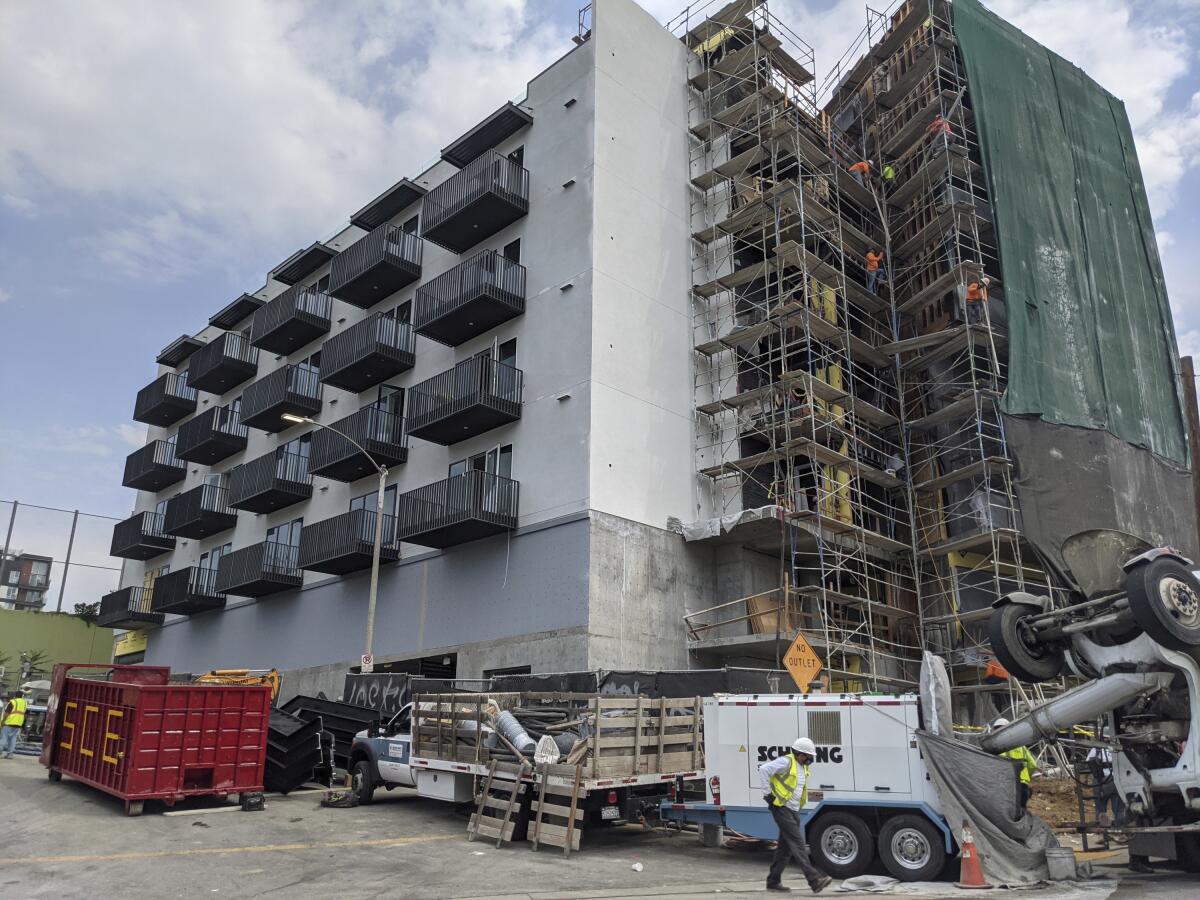L.A. must add more than 250,000 homes to zoning plan by October, state rules

Los Angeles must rezone to accommodate an additional quarter-million new homes by mid-October after state housing regulators rejected the city’s long-term plan for growth.
The likelihood that L.A. will be able to accomplish in months a task that would normally take several years is very low, but the cost of failure could be high, experts say.
If city leaders do not fix the housing plan or complete the rezoning by the new deadline, they could lose access to billions of dollars in affordable housing grants, officials with the state Department of Housing and Community Development said in a letter this week.
Without the money, the production of new housing for low-income and homeless residents throughout L.A. would take a massive hit at a time when more than 41,000 people are homeless and soaring rents and the COVID-19 pandemic are making it harder for Angelenos to stay in their homes.
Gustavo Velasquez, director of the state housing department, praised the city’s efforts to develop a plan that welcomes new housing, promotes the construction of low-income apartments and ensures protections against displacement of residents.
But he said the city hasn’t done enough to comply with new, stricter state laws designed to promote greater development across California.
Currently, just seven local governments in Southern California have state-approved housing plans. Another 190 are now out of compliance, state officials said, and they face the same funding and rezoning restrictions that L.A. does.
Given the city’s sheer size, it’s unlikely L.A. could meet the rezoning requirements under such a tight deadline.
“This is the most densely populated city in the state,” Velasquez said. “It’s a lot of work. To be perfectly honest, I don’t know how anybody could think that the rezoning could be done between now and October.”
State officials have applauded the city’s intentions to reverse historic patterns of development and rezone wealthier, lower-density communities, such as those on the Westside and in the San Fernando Valley, to allow for more low-income housing. But they said L.A.’s plan doesn’t demonstrate that it has sufficient strategies to invest in new parks or economic development in poorer neighborhoods, among other concerns.
The finding comes after years of contention among Gov. Gavin Newsom, state lawmakers and cities across California over growth. Newsom and some legislators have argued that local restrictions on development are a key reason why housing costs are so high in California, causing crushing rent burdens and rising homelessness.
In recent years, they’ve passed new laws allowing for some affordable housing projects to get built without local review and fourplex dwellings to be built on land previously reserved only for single-family homes.
The state also has attempted to strengthen a 50-year-old law that requires every local government to prepare a plan every eight years for new growth to meet projected population increases and account for other factors, such as overcrowding, that indicate a need for more development. The process, known formally as the housing element, doesn’t require local governments to build or approve new housing, instead mandating that they must zone sufficient land to meet the state’s housing goals.
Until recently, many cities skirted the state’s housing law with little consequence.
But the new rules have substantially increased the number of new homes cities must allow. In Southern California alone, local governments must plan for the construction of 1.3 million new homes by 2029 — triple the number required during the previous cycle. And cities now must show that the properties they’re targeting for new development are more likely to have housing built on them.
Before the housing department’s decision this week, the city of Los Angeles had seemed to be in lockstep with the state’s efforts. Mayor Eric Garcetti and City Council members had pushed successfully in fall 2019 for L.A. and other communities near the coast to plan for more housing rather than continue to push sprawl further into the Inland Empire.
Experts have widely praised the city’s efforts for identifying realistic sites suitable for housing construction, rather than attempting to shirk that responsibility.
“Our housing element is the most ambitious and aggressive in the state, as part of a new regulatory process with unprecedented housing goals, and the mayor is proud of the work city staff have done to bring it to this point,” Alex Comisar, a Garcetti spokesman, said in a statement.
Nevertheless, the failure to win state approval of the city’s plan could have serious consequences.
Under the law, Los Angeles is no longer eligible for money from many state affordable housing programs. That includes one that in January delivered more than $125 million to support city low-income housing developments.
Both state and city officials said that the city should be able to make changes to its housing plan by May, when the next round of state housing funding becomes available, so they don’t expect the city to lose out on money in the short term.
But the rezoning deadline poses a far more difficult challenge.
L.A. must complete efforts to rezone for 255,000 new homes by mid-October — rather than the three years it would have otherwise had to do it.
City and state leaders say that doesn’t seem remotely possible. The process ordinarily requires lengthy environmental reviews and the L.A. City Council would have to approve the rezoning plan, after all of that, in just eight months. This would all happen amidst a mayoral election — as well as City Council races.
“Rezoning the entire city in one year is infeasible, and we don’t believe that penalty was meant to apply to jurisdictions pursuing compliance in good faith,” Comisar said, adding that the mayor planned to work with Newsom and state legislators to address the issue.
The state’s rejection of L.A.’s housing plan could backfire, said Chris Elmendorf, a UC Davis law professor who has been following the housing element process.
Lumping L.A. in with cities that are actively trying to evade the law could delegitimize the housing department’s actions, he said, and cause the courts to allow local governments to ignore the rezoning deadlines if they are determined to be impossible to meet.
“This is politically bonkers,” Elmendorf said.
But Paavo Monkkonen, an associate professor of urban planning and public policy at UCLA, said the state’s move was justifiable given the city’s rejection of even more assertive state-led rezoning proposals in favor of greater local control over where growth should go.
Allowing more housing more quickly will benefit Angelenos, he said.
City officials, Monkkonen said, “shouldn’t drag their feet on taking the necessary actions to allow more housing, and should act at the pace that a crisis demands.”
The Times’ Liam Dillon and CalMatters housing reporter Manuela Tobias chat about the latest developments in California housing policy and interview key newsmakers and other reporters. Available on Apple, SoundCloud, Spotify, Google and Stitcher podcasts.
Earlier this month, the Southern California Assn. of Governments, a public agency representing 19 million residents in Los Angeles County and five neighboring counties, sent a letter to state lawmakers asking for a legislative committee hearing to address the timelines.
Velasquez said the state’s aggressiveness in pushing cities to comply with their deadlines shows that, after decades, California is taking the planning process as seriously as its housing problems require.
“It’s showtime,” he said. “We just want to make sure that people are doing what they’re supposed to be doing and taking this crisis that we’re facing really seriously.”









